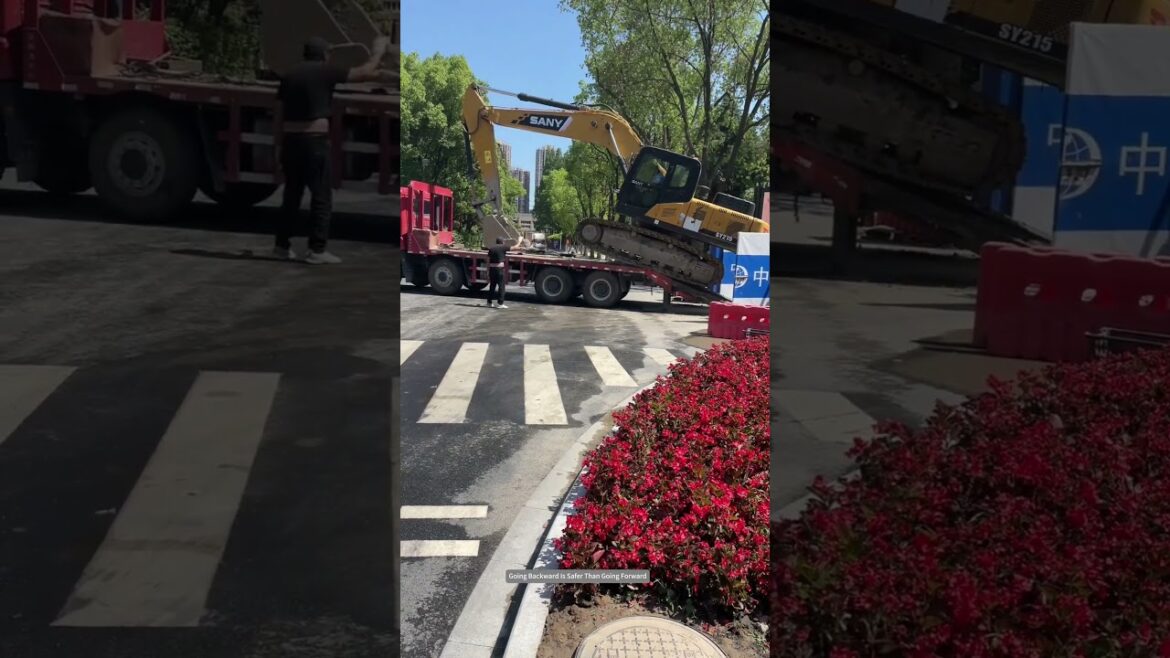It is safer for an excavator to board the trailer backward than forward.The main reasons are as follows :
1. Better Vision
When boarding the trailer backward, the excavator driver can see the distance between the tracks and the edge of the trailer more clearly through the rearview mirror, thereby better controlling the position and direction of the excavator and reducing the risks of collision and slip page !
2. More Stable Center Of Gravity
The center of gravity of an excavator is usually at the front. When boarding the trailer backward, the center of gravity is relatively at the rear, which can make the change of the center of gravity smaller during the entire boarding process, be more conducive to maintaining balance, and reduce the possibility of roll over !
3. More Flexible Operation
When boarding the trailer backward, the bucket of the excavator is at the rear, which is convenient to use the bucket to support the ground when necessary, increasing stability and adjusting the boarding angle !
4. Reduced Risk Of Track Slippage
When boarding the trailer forward, the front end of the track contacts the trailer first. If there are foreign objects or unevenness on the surface of the trailer, it is easy to cause the front end of the track to slip; while boarding backward, the rear end of the track contacts the trailer, and the risk of slippage is relatively smaller !
5. Facilitated Emergency Braking
When boarding backward, the driver can observe the rear situation more directly. Once any anomaly is detected, the braking measures can be taken more quickly to avoid accidents !
In conclusion, when an excavator boards the trailer backward, it has advantages in terms of vision, center of gravity, operational flexibility, reduced risk of slippage, and emergency braking. Therefore, it is relatively safer !
To Ensure The Accuracy Of The Boarding Angle When An Excavator Is Reversing Onto The Trailer, The Following Measures Can Be Taken :
1. Observe And Plan In Advance
Before boarding, carefully observe the position, height, slope of the trailer, and the surrounding environment, and plan the best boarding route and angle !
2. Identify Reference Points
Determine some fixed reference points in the trailer and the surrounding environment, such as specific positions on the edge of the trailer, marks on the ground, or other obvious objects. During the reversing process, adjust the angle by observing the relative positions of these reference points and the Excavator !
3. Operate Slowly
Reverse slowly and smoothly, avoiding hasty movements. This allows for more precise control of the excavator’s movement, enabling timely detection of angle deviations and adjustments !
4. Utilize Rearview Mirrors And Monitoring Equipment
Make full use of the rearview mirrors of the excavator and possibly equipped monitoring devices to observe the relative position and angle between the excavator and the trailer from multiple angles to obtain comprehensive information !
5. Cooperate With The Commander
If there is a commander on site, maintain good communication and cooperation with them. The commander can provide accurate instructions from different perspectives to help adjust the boarding angle !
6. Practice And Accumulate Experience Through multiple practical operations, accumulate experience, become familiar with the performance and operation characteristics of the excavator, and thereby be able to judge and control the boarding angle more accurately !
7. Adjust The Track Direction In Advance Before starting to reverse, appropriately adjust the direction of the tracks based on the expected boarding angle to prepare for accurate boarding !
8. Get Off To Check And Adjust
If there are doubts about the angle during the reversing process, you can temporarily stop, get off to check the actual situation, and then make adjustments !
Through the comprehensive application of the above methods, the accuracy of the boarding angle when the excavator is reversing onto the trailer can be improved, ensuring the safety and smoothness of the operation !
source

